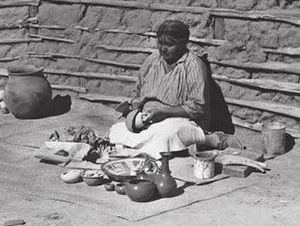Ida Redbird facts for kids
Quick facts for kids
Ida Redbird
|
|
|---|---|

Redbird in 1940, Sayles image, using a paddle to thin the wall of a pot she is creating
|
|
| Born | March 15, 1892 Laveen, Gila River Indian Reservation, Arizona
|
| Died | August 10, 1971 (aged 79) Gila River Indian Reservation
|
| Nationality | American, Gila River Indian Community |
| Occupation | potter |
| Years active | 1930–1970 |
| Known for | 1940s Maricopa pottery revival |
Ida Redbird (1892–1971) was a famous Maricopa potter. She lived in the Gila River Indian Community in Arizona.
Ida was the first leader of the Maricopa Pottery Maker's Association. Many people say she helped bring back old Maricopa pottery making styles. Her special black-on-red pottery was very popular with collectors. A photographer named Ted Sayles took pictures of Ida making her pottery. These photos were shown in museums across the Western United States.
Contents
Ida Redbird's Early Life
Ida Redbird was born on March 15, 1892. Her birthplace was Laveen, which is on the Gila River Indian Reservation in Arizona. Her mother was Hoot Somegustava.
Ida's family had roots in both the Tohono O'odham and Maricopa tribes. Ida went to the Phoenix Indian School. Her teachers remembered her as a quiet and serious student. She learned how to make pottery when she was very young.
Ida Redbird's Pottery Career
In the 1920s, Ida helped a researcher named Leslie Spier. She translated for him while he studied the Yuman tribes. By the 1930s, her pottery became well-known.
She sold her work to dealers in Los Angeles. However, she only got a very small amount of money for each piece. Even though times were tough during the Great Depression, she wanted to get fair prices.
Improving Pottery and Prices
Ida decided to help other potters. She worked with Elizabeth Hart, who helped Native American communities. Ida wanted to make sure potters could sell better quality items for more money.
Her hard work earned her the respect of other potters. They chose her to be the first president of the Maricopa Pottery Maker's Association. This group helped potters work together.
Ida's Unique Pottery Style
Ida Redbird's pottery was usually a shiny red color. She painted designs on it using black slip, which is a liquid clay. She used a special method called the paddle-and-anvil technique. This was different from the coil method many others used.
This technique was first used by ancient Hohokam artists. Ida used local clay from the Gila Riverbed. After a pot dried for a few days, she put a red clay from the Superstition Mountains on it. Once that dried, she polished it with a stone.
Then, she fired the pot outside. While the pot was still hot, she painted geometric shapes on it. She used a special dye made from boiled mesquite bark.
Sharing Her Art and Knowledge
In 1940, a man named E. B. "Ted" Sayles took pictures of Ida. He showed her making pottery step-by-step. These photos were displayed at the Abilene Fine Arts Museum in Texas. They were also shown in Arizona Highways Magazine in 1948.
From 1941 until she passed away, Ida taught summer classes. She also showed her pottery at the Heard Museum in Phoenix, Arizona. She and another potter, Mary Juan, taught pottery classes at Casa Grande.
In 1949, Ida helped Lenora S. M. Curtin with her study of the Pima people. Curtin said Ida was one of the two best Maricopa potters. She also noted that Ida was good at using plants for medicine, like an herbalist. Many experts agreed that Ida was one of the best Native American potters in the Southwest. However, Ida herself believed Mary Juan was even better.
Ida showed her work at many events. These included fairs, museums, and gatherings like the All-Indian Fair in Lake George, New York. She also showed her work at the 1968 Tohono O'odham Powwow in Casa Grande.
Ida Redbird's Legacy
Ida Redbird passed away on August 10, 1971. She had just finished some pots and was resting under a tree on the reservation. Sadly, the tree fell on her, and she died.
Soon after her death, the Heard Museum held a special display of her pottery. In 1985, Ida Redbird was honored. She was added to the Arizona Women's Hall of Fame. In 2015, her work was part of an exhibit at the Amerind Museum and Art Gallery. This exhibit featured pottery from many Arizona Native American artists.

